Tropical Fruit Guide
Over 150 different varieties of tropical fruits are grown in Tropical North Queensland. Here is just a taste of the wonderful ultra tropical fruits you will find at the Feast of the Senses!
Thanks to the South Johnstone DPI for this information and images

There are three species of dragon fruit (pitaya) normally grown and marketed (Hylocersus undatus (red skin white flesh), Hylocerus polyrhizus (red skin red flesh) and Selenicereus megalanthus (yellow skin with white flesh). The fruits are members of the cactus family. They are popular among immigrants of Vietnamese decent. The fruit are an attractive addition to a fruit platter. Some consider the flesh bland. The red fleshed species lends itself to be used as a base for exotic spiced or sweet sauces. Dragon fruit is currently the most prolific species recorded in the survey with 50,100 planting sites. The bulk of the plantings are in the NT (34,150 sites or 62.2% of total plantings). The survey did not distinguish between the three species but experience suggests that the bulk of the plantings in the NT are based on Hylocerus undatus while Queensland produces a high proportion of Hylocerus polyrhizus. The third species (S. megalanthus) is usually grown in small quantities. The farmgate value of the pitaya industry, based on the survey data, is $2.25M from a production of 750 tonnes.

Rambutan (Nephelium lappaceum) has been the main stay of the tropical exotic fruit industry. The fruit is the “tropical” cousin of lychee and longan. The attractive soft spined exterior skin surrounds the sweet translucent to white flesh containing one seed. Rambutan’s are best eaten as a fresh fruit. The majority of trees are located in north Queensland (approx 20,000 or 79.7% of total plantings) with approximately 5000 trees recorded in the NT. The production potential of rambutan, at a modest yield of 25 kg per tree, is 627 tonnes valued at $3.76M. Rambutan production is dependent on ideal environmental conditions. Hence yearly production is highly variable.

Mangosteen (Garcinia mangostana) is considered the “Queen” of tropical fruit. The thick purple skin surrounds a number of white fleshed citrus like segments which may contain one or two seeds. Mangosteen is primarily grown in north Queensland (11,606 trees or 98.6% of total plantings). The remaining 163 trees are recorded in the NT. This is not unexpected given that mangosteen is not ideally suite to the monsoonal tropics. The production potential of mangosteen, at a modest yield of 15 kg per tree is 176 tonnes valued at $1.77M. Mangosteen production is dependent on ideal environmental conditions. Hence yearly production is highly variable.

Jackfruit (Artocarpus heterophyllus) is a relative of breadfruit and mulberry and is chiefly grown for its ripe fruit that is eaten fresh or used in desserts and sweet drinks. Green fruit is also commonly used in vegetable curries and the seed of ripe fruit can be eaten after being boiled or roasted. Jackfruit is an increasingly important fruit with major plantings in The NT (7,240 trees, 78.1% of total production). The remaining 2,031 trees are grown in north Queensland. Fruit are supplied as immature green for use in curries or as whole mature fruit. The fruit also has an important profile in farmers markets in the NT. The estimated production potential of Jackfruit, at a yield of 80 kg/tree is 741 tonnes valued at $2.6M. Selected varieties of Jackfruit are assumed to have potential for the fresh cut market. This would allow the fruit to be introduced to a new market.

The pomelo (Citrus grandis) a citrus best suited to the hot humid tropics, is the largest of the citrus fruits with specimens recorded up to 6 kg in weight. Pomelos are round or pear shaped depending on cultivar and tend to have relatively thick rind. Skin colour is generally light green, yellow or light pink. The flesh varies in colour from pale yellow to pink. The juice sacks are large and lightly crunchy containing a mildly sweet acidic juice. The fruit is a favourite among Chinese people, particularly during festivals such as Chinese New Year and the Moon Festival. Pomelo is grown widely in tropical north Australia with major plantings in the NT (4,100 trees or 76.7% of total). The fruit are growing in acceptability in the market and are being increasingly utilised by high-end restaurants in fusion style salads. The estimated production potential of pomelo, at a yield of 60 kg/tree is 321 tonnes valued at $0.96M.

Durian (Durio zibethinus) the “King” of tropical fruit perfectly represents the term “exotic fruit”. A fruit armoured with spines and a pungent odour when ripe. The creamy edible flesh surrounding the seeds has a flavour similar to garlic custard. The bulk of trees accounted for in the survey are in the NT (3,107 or 62.2% of total). The remaining 1,888 trees in Queensland are the survivors following cyclone Larry. Pre Larry stock-take suggested that there were up to 13,000 durian trees planted in north Queensland. The estimated production potential of durian, at a yield of 12 kg/tree is 60 tonnes valued at $0.48M.
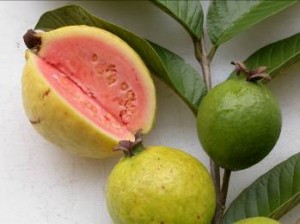
Guava (Psidium guajava) is well known for its use as an ingredient in tropical juices. The skin and interior flesh containing small seeds are edible when immature as a crisp fruit or as a mature soft fruit. Flesh colour varies with variety from white to salmon pink. The white fleshed fruit are supplied to the market as mature unripe for fresh fruit consumption. The pink fruit are supplied for fresh fruit consumption as ripe fruit. The fruit, in particular the pink fleshed varieties, have recently gained notoriety with exposure on Master Chef®. Guava is an underrated fruit with major plantings in The NT (3,290 trees or 86.2% of total production). The remaining 525 trees are grown in north Queensland. The estimated production potential of guava, at a yield of 30 kg/tree is 114 tonnes valued at $0.5M.

Carambola (Averrhoa carambola) or star fruit has been widely grown as a back yard fruit tree along the SE coast of Queensland and northern Australia. Commercial plantings exist from northern NSW, southern and central Queensland and the rural regions surrounding Darwin. The main commercial cultivars are B2, B10, B17, Arkin, Fung Tung and Giant Siam (Diczbalis and McMahon 2004). The fruit is primarily grown for the food service market where it is used as a garnish surrounding fruit platters. The survey indicates there are 2,200 trees (65.7%) planted in Queensland with the bulk of commercial trees in regional areas surrounding Rockhampton and Bundaberg. The remaining 1,150 trees are grown in the Darwin rural area. The estimated production potential of carambola, at a yield of 45 kg/tree is 150 tonnes valued at $1.21M. Opportunities exist for industry expansion if the fruit can be introduced to the larger Australian market. The fruit is highly versatile as a fresh fruit and a refreshing juice.

Soursop (Annona muricata) or guanabana is a relative of the better known custard apple and native to central and South America. The fruit flesh is ideal for use in tropical flavoured ice-creams and juices. Recently the fruit is being touted on the internet as having anti cancer properties (http://www.buzzle.com/articles/soursop-and-cancer-cure.html). This has resulted in increased demand for product. The bulk of soursop is grown in north Queensland (2,440 trees or 97.6% of total plantings). There are reported to be 60 trees in the NT. The estimated production potential of soursop, at a yield of 20 kg/tree is 50 tonnes valued at $0.30M. Opportunities exist for industry expansion if the fruit can be successfully introduced to the specialist food service market.
Secondary species

Duku–Langsat (Langsium domesticum) is a relatively unknown fruit in Australia although well known in Thailand, Malay Peninsula and the Indonesian islands. The fruit are borne in grape like clusters on the trunk and main branches of the tree. The fruit is covered in a leathery skin which is easily peeled to reveal two to three translucent flesh segments. Immature fruit produce latex at the edge of the broken skin. Fruit may contain one greenish seed similar in size to a pumpkin seed. In most cases the seeds are aborted. The flesh has a refreshing flavour with a hint of acidity. The survey revealed a surprising number of trees in northern Queensland and the NT. There are 1,200 trees planted in north Queensland (68.7%) with a further 550 trees (31%) in the NT.

Star Apple (Chrysophyllum cainito) is an attractive fruit native to South America but well know through Asia with a particular following in the Philippines. Trees are grown throughout northern Australia where they are often planted for their attractive foliage. The survey data suggests there are a total of 1,717 trees with the bulk (68.3%) grown in the NT. There are purple skinned (Cv. Grimal and Haitian) and green skinned (cv. Philippine Gold) fruit with green skinned fruit generally receiving a higher market price.
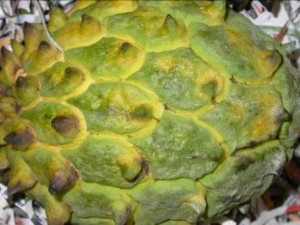
Rollinia (Rollinia deliciosa) also known as Biriba is a relative of custard apple native to tropical central America and south America. The fruit is a yellow and heart shaped with a bumpy surface of soft leathery spines. The soft white tasty flesh is interspersed with black seeds which are not eaten. The tree is commonly propagated by seed and no varieties exist in commercial production. The fruit is challenging to move when ripe but a number of specialist growers are managing to get the fruit to southern markets. Fruit are best eaten fresh or can be used in cooking (cheese cakes and ice creams). The survey suggests that 100% of the crop is grown in far north Queensland (1,330 trees). The tree bears early and prolifically.

Sapodilla (Manilkara zapota) or chico is native to Mexico and central America. The fruits aromatic and sweet “brown sugar” like flesh has lead to its cultivation throughout tropical regions of the world. It is particularly popular in India and latex from the trees was extracted as the base for chewing gum prior to the development of synthetic gum base. The survey suggests there are 1,076 trees with 79.6% (856 trees) in north Queensland and 220 trees in the NT. The tree is ideal for back yard production. The fruit lends itself to fresh eating and the flesh can be stirred into creams, ice creams and mousse.

Hog Plum (Spondias cythera) or Fiji Apple, Ambarella, Vi Apple or Otaheite Apple is a member of the mango and cashew family. The fruit, dark green in colour, is plum shaped sweet-sour to taste and is eaten at all stages of ripeness. The fruits have a distinct spiny seed that hardens as the fruits mature thus requiring care when the flesh is sucked from the seed. Although the fruit is native to the Pacific it is now commonly grown and eaten throughout SE Asia and Central America. The fruit is grown commercially in the NT with 890 trees representing 97.3% of total plantings. Fruit is produced from two major selections a large tree and a dwarf variety.

Abiu (Pouteria caimito) originates from South America in the tropical regions of Peru and Brazil. The yellow fruit is round to oval in shape and some varieties have a nipple like protrusion at the end of the fruit. The fruit is best eaten fresh to reveal the subtle caramel flavoured flesh. There are a number of selections which include Gray, Z2, Z4 and E4. There are a total of 610 trees with 73.8% (450 trees) in north Queensland and 122 trees in the NT. Abiu was regarded as an exotic fruit with potential (Ross 1997). Production is generally not a problem. The fruit bruises easily and the major challenge is getting unbruised fruit to market.

Breadfruit (Artocarpus altilis) is a fruit native to the Pacific islands and is inexorably connected to Captain Bligh who was responsible for transporting the trees from Tahiti to the West Indies. The fruit is an important staple food in the Pacific and can be used for making crisps and chips. The tree is truly tropical in its requirements and is ideally suited to NT. In Queensland its range is currently restricted to areas north of Cairns or elevated areas, free of the influence of cold air drainage, south of Cairns. The survey suggests there are nearly 500 trees with 350 trees (74.2%) located in north Queensland. The remaining 120 trees are planted in the rural areas adjacent to Darwin.
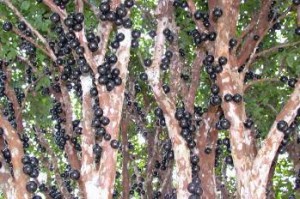
Jaboticaba (Myrciaria cauliflora) are native to southern Brazil. The fruit are produced directly on the main trunk and branches and are similar in appearance to a large black skinned grape. The skin of jaboticaba is relatively thick and contains a translucent flesh similar to a grape. The fruit are delicious when eaten fresh and would lend themselves to being presented in a punnet similar to temperate berries. The survey suggests there are 441 commercial trees with all of them present in north Queensland. Jaboticaba will also grow successfully in sub tropical areas such as south east Queensland.
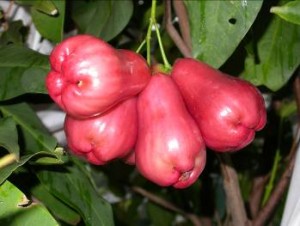
Malay and Water Apple (Syzygium malaccense and S. aqueum) are native to the Indo Malay region. Malay and Water Apple are closely related to Australia’s lillypillies but are larger fruit in comparison. The fruit vary in colour, white to deep crimson red, and usually have a crisp white flesh. The whole fruit is edible except for a seed which is found in the Malay Apple. The fruit is traditional eaten fresh with an accompanying spiced salty dry dip. The fruit lends itself to fresh salads. The survey records suggest there are 383 trees in production with the bulk of trees (79% or 303 trees) being grown in the NT. The remaining trees are produced in north Queensland.
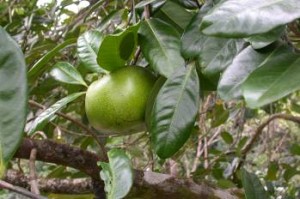
Black Sapote (Diospyros digyna) or chocolate pudding fruit is native to Mexico and a close relative of persimmon. The fruit is easily produced in the tropics from a variety of seedling selections. Large squat fruit are preferred to the smaller oval types. The fruit is a culinary fruit because it is best used in recipes where it is used in association with chocolate or as a replacement for chocolate colouration. The fruit are climacteric and can be picked green mature. They are best to consume when fully softened. The tree is hardy and is used successfully as a windbreak. The tree is well adapted to warmer sub tropical areas as well as the wet coast of north Queensland. There are an unquantified number of trees in northern Australia. Market demand is increasing due to interest in the fruit from chefs.

Achacharu (Garcina humilis) is a fruit recently introduced from Bolivia. It is related to mangosteen and is borne on a tree similar in appearance but with smaller lancolate leaves and more sun tolerant. The trees of the variety “A-SE” (17,000 trees) are owned (under plant variety rights) by one company and planted in an area south of Townsville. The fruit is bright yellow in colour and egg shaped. The white crisp flesh, surrounding a single seed is slightly acidic in nature and is delicious fresh. The skin can be used to make a refreshing drink and the flesh also lends itself to being used in purees and juices.
There are many more tropical exotic fruit species grown for commercial gain as well as by collectors (Table 6). Many of these are believed to have commercial potential and entrepreneurial growers are testing the commercial realities of a number of these fruits. Species such as Acerola (Malpighia glabra), Grumichama (Eugenia braziliensis), Canisel (Pouteria campechiana), Kwai muk (Artocarpus hypargyreus), Rambai (Baccaurea motleyana), Mamey sapote (Pouteria sapota) and Miracle fruit (Synsepaleum dulcifium) are some of them.

